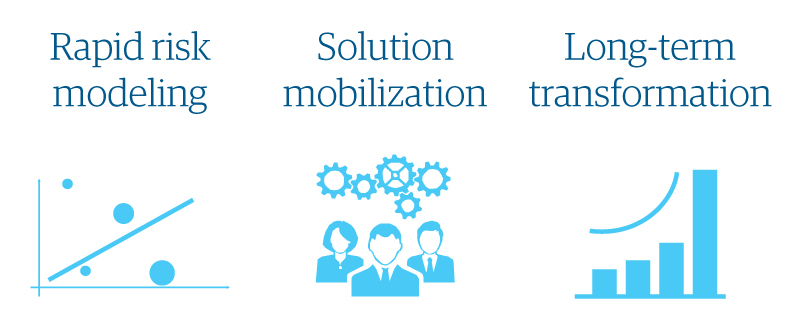- Point of view
Business resilience: A hidden benefit of data analytics
Explore how leading enterprises rely on the power of data to future-proof operations and enhance agility

Disruption and uncertainty have pushed enterprise leaders to develop new strategies to protect both their people and performance. At the center of these efforts are analytics teams who play essential roles in helping businesses manage risk – with data at the heart of every decision.
Guided by advanced analytics, teams can predict new trends, adapt to the changing business landscape, and build resilient operations. Whether it is a global pandemic, climate change, or even war, agility and speed have become the new currency of business.
Here, we explore three ways analytics supports business resilience and continuous innovation, showing you the benefits of a successful analytics strategy.
From crisis management to rapid action
To face the unknown confidently, many organizations have established rapid action teams that can proactively respond and manage risk. Using data-driven insights, these teams can devise methods to revitalize cash flow, improve liquidity, strengthen supply chains, and improve customer communications. By embracing rapid risk modeling, solution mobilization, and long-term transformation (figure 1), rapid action teams are setting the pace for greater responsiveness and resilience. Let's take a closer look.

Rapid risk modeling
For many enterprises, supply chain issues can wreak havoc on their business. From economic crises to natural disasters, supply chain operations are at constant risk of disruption.
By harnessing the power of artificial intelligence (AI) and machine learning (ML), rapid risk models detect, verify, analyze, and forecast potential outcomes from these threats, providing early warning signals and potential solutions. With this information, enterprise leaders can make more strategic decisions about procurement, capacity planning, and worker safety.
Case study
Managing supply chain risk with data-driven insight
In supply chain, analytics models can forecast the likelihood of suppliers shutting down and the risks associated with worker safety, order fulfillment, and human rights.
For example, we worked with a global brewer to deploy a digitally powered supplier risk management system that monitors and screens over 50,000 suppliers. This initiative helped identify suppliers that do not align with the brewer's high standards, preventing the company from supporting ethically unsound businesses. As a result, some suppliers re-examined their business practices, creating a more sustainable ecosystem for all.
Solution mobilization
While exploring new risk models, businesses also need to empower their digital and analytical teams to develop solutions that support other strategic priorities – such as strengthening demand forecasting and planning. In essence, solution mobilization allows multidisciplinary teams to collaborate to share their expertise and experiences to solve problems faster. However, for this process to run smoothly, organizations must democratize access to data, enabling all relevant teams to access, analyze, and extract information from the treasure trove of data at their fingertips.
Case study
Using predictive analytics to act with agility
In nearly every industry, demand can drastically spike or drop at a moment's notice. To stay ahead of the curve, enterprise leaders rely on data-driven decisions to navigate the unexpected.
For example, at the height of the COVID-19 pandemic, we partnered with a medical equipment manufacturer to enhance its production capacity. By using infection rate data, we developed a forecasting solution that could predict demand for non-COVID and elective treatments. Equipped with real-time predictive analytics, teams could quickly review production capacities and redesign their supply chain network to meet changes in demand.
Long-term transformation
To effectively prepare for the future, enterprises must also focus on embracing sustainable and ethical business practices. Research shows that data-driven sustainability can drive significant competitive advantages, power innovation, and bolster financial performance – while delivering long-term value for everyone.
A responsible approach to analytics means rooting out potential biases, like gender or race discrimination, when developing new products and services. To create analytics solutions that are fair, trustworthy, and accountable, enterprises are building centers of excellence that act as ethics boards.
Case study
Acting ethically in banking
A financial services firm set out to streamline loan approvals while removing potential biases from the loan review process. The bank partnered with us to implement a responsible AI framework, which removed variables like gender and education to increase the probability of a fair decision. We also developed a monitoring system to alert the AI ethics board of potential issues. The success of this project laid the foundation for deploying similar descriptive analytics models across the organization.
Connecting people, processes, data, and technology for greater agility
Enterprise leaders are adopting agile principles to enhance their analytics process and manage disruption. Originally created for software development programs, agile methods bring the speed and flexibility teams need to modernize traditional business operations – with data as the driving force.
Agile principles work exceptionally well when businesses need to act and adapt quickly. For example, sprint cycles that were once managed over weeks now only require days – or even hours, sometimes. The benefits are even more significant when organizations embrace agile techniques with advanced analytics and reskilling programs.
Here are some examples:
Case studies: The business operations shift
Agility with analytics and AI
An insurer saw a significant spike in contamination, arson, and theft claims, but its claims teams were already spread thin. So, Genpact partnered with the insurer's team to create a connected planning solution supported by agile principles, prescriptive analytics, and AI. By automating the claims process, we streamlined operations, easing the burden on employees while improving the planning strategy. Now, machines can fast-track straightforward cases, freeing humans to focus their efforts on more complex issues.
Agility with analytics and cloud
The need for enterprises to become data-driven has prompted organizations to transition all data to the cloud to support more agile, flexible operations and power analytics at scale. With a solid cloud strategy, businesses can reduce the time it takes to turn data into insight and empower employees across their organizations to act with speed and agility. Data on cloud also supports other capabilities, like intelligent automation, data visualization, and process mining, setting the foundation for continuous innovation.
Agility with analytics and automation
A leading global retailer struggled with data silos. It had 20 nonintegrated systems processing 6 million invoices across its stores and warehouses, leading to supplier disputes – over 70% of which ended in refunds. To enable speed and agility, we developed a procure-to-pay data fabric. Seamless data management – enhanced with machine learning and automation – now match the right invoices to the correct receipts. As a result, the employee and supplier experiences have improved, and disputes have decreased by 40–50%.
Agility with empowered employees
By 2030, the World Economic Forum estimates that more than 1 billion people – nearly one-third of the jobs worldwide – will need reskilling to keep pace with digital disruption. To help Genpact employees succeed, we've launched DataBridge, an initiative to increase data literacy across our organization and shift employees away from transactional projects into insight-generating roles. In essence, we aim to equip about 100,000 employees with the data and analytics tools, techniques, and skills they need to succeed today and in the future.
The time to act is now
The events of recent years have shown the importance of data-driven business intelligence to achieve resilience and speed. They've revealed the strategic benefits of analytics and how augmented intelligence in business can positively impact operations, products, services, stakeholders, and customers for years to come. In our view, there has never been a better time to act and build strong, sustainable business practices that can support your workforce's efforts to thrive in the new normal.

